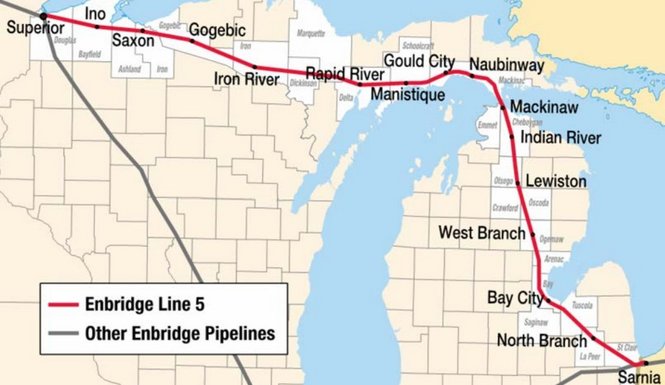Tunnel, Trench Offer Options for Replacing Pipeline
By John Flesher, AP Environmental Writer
TRAVERSE CITY, Mich. (AP) – A 65-year-old pipeline that carries crude oil beneath a sensitive waterway connecting two of the Great Lakes could be replaced with pipes buried in a tunnel or partially enclosed in trenches that would pose virtually no risk of leakage but require years and hundreds of millions of dollars to build, according to a report released Friday.
Enbridge, the Canadian company whose Line 5 runs 645 miles (1,038 km) between Superior, Wisc., and Sarnia, Ont., produced the analysis of possible alternatives for replacing the 4.5-mile-long (7-km-long) segment at the bottom of the Straits of Mackinac between Lakes Huron and Michigan.
The study was required under an agreement between the company and Michigan Gov. Rick Snyder amid rising concern about the safety of Line 5, which recently sustained slight damage from a suspected ship anchor strike and has been the target of a campaign by environmentalists demanding it be shut down.
"Line 5 cannot remain in the straits indefinitely. We need a concrete strategy and timeline to expedite its replacement," Snyder said. "This report will help us define a comprehensive solution for all utility crossings."
Enbridge insists the underwater segment – which is divided into two 20-inch (51-cm) lines – has never leaked and remains in good condition. But spokesman Ryan Duffy said the Calgary, Alberta-based company is "committed to exploring the eventual replacement of the section in the straits."
The report is the first of four Enbridge has agreed to provide this month. Others will deal with potential improvements to Line 5, ways to prevent more anchor strikes and an assessment of risks to other important waterways that Line 5 crosses.
A final decision on Line 5’s future is expected this fall.
The company hired engineering firms with expertise in tunneling, offshore pipelines and horizontal drilling to analyze the workability of three replacement alternatives. Other outside experts studied how the projects would affect the environment in the straits, a tourist destination and important tribal fishing area.
The report concludes two alternatives would be feasible.
The first would route a new pipeline segment inside an underground tunnel up to 100 feet (30 meters) beneath the lakebed. It would be 12 feet (3.5 meters) in diameter and contain one 30-inch (76-cm) pipeline. The concrete tunnel would feature reinforced lining to provide extra protection in case of pipeline failure.
The likelihood that oil would find its way into open water from the tunnel would be "virtually zero," the report said.
It estimated the tunnel option would take up to six years to complete and cost $350 million to $500 million.
The second alternative, known as the "open cut method," would place a new, double-layered pipeline along the lake bottom. Sections in shallow areas with water depth up to 30 feet (9 meters), which extend roughly a half-mile offshore on both sides of the straits, would be buried in a trench. Sections in deeper areas would rest directly on the lake bottom, covered with a cobble and gravel layer six to eight feet thick.
It would take up to five years to complete and cost $250 million to $300 million with an "extremely low" risk of leaks, the report said.
The analysis dismissed a third alternative as unworkable: running a pipe through an opening that would be drilled horizontally from onshore.
"Both feasible alternatives would help ensure the continued safety and protection of the Great Lakes for future generations, and we look forward to our continued collaboration with the State to further explore the viability of these options," Enbridge said in a statement.
Environmental groups complained the analysis ignored their preferred action: shutting down Line 5 and finding routes other than the Straits of Mackinac for transporting the 23 million gallons of oil and natural gas liquids it carries daily.
"In a time of water shortages and changing climate in this century, it doesn’t make sense to even contemplate constructing Canadian oil pipelines in a tunnel under the world’s largest supply of fresh surface water," said Liz Kirkwood of the Oil & Water Don’t Mix coalition.
Related News
Related News

- Intensity, Rainbow Energy to Build 344-Mile Gas Pipeline Across North Dakota
- Energy Transfer to Build $5.3 Billion Permian Gas Pipeline to Supply Southwest
- Enbridge Sees High Demand to Expand 593-Mile Canada-to-U.S. Gulf Oil Pipeline
- Strike Pioneers First-of-Its-Kind Pipe-in-Pipe Installation on Gulf Coast with Enbridge
- 208-Mile Mississippi-to-Alabama Gas Pipeline Moves Into FERC Review
- A Systematic Approach To Ensuring Pipeline Integrity
- 275-Mile Texas-to-Oklahoma Gas Pipeline Enters Open Season
- LNG Canada Start-Up Fails to Lift Gas Prices Amid Supply Glut
- Strike Pioneers First-of-Its-Kind Pipe-in-Pipe Installation on Gulf Coast with Enbridge
- Enbridge Sees High Demand to Expand 593-Mile Canada-to-U.S. Gulf Oil Pipeline





Comments